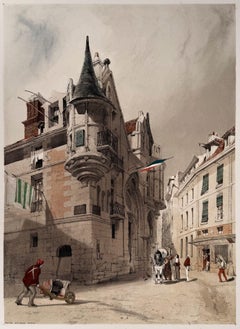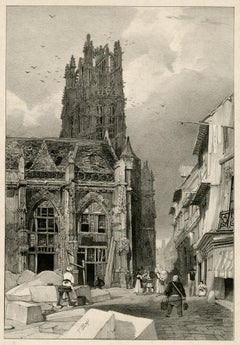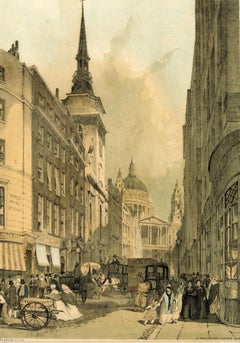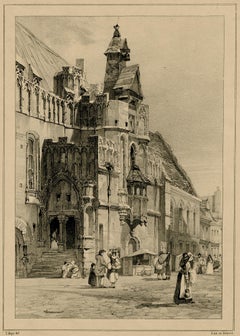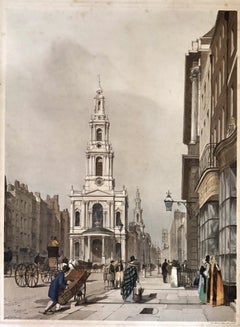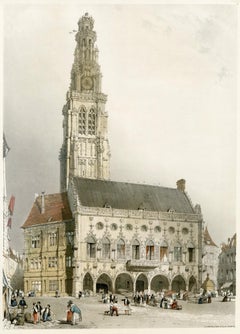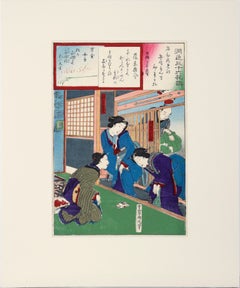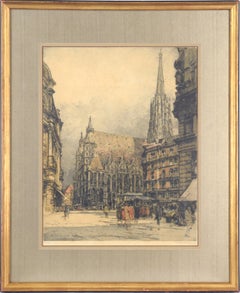Handmade Paper Landscape Prints
to
10
1
Overall Width
to
Overall Height
to
50
11
3
3
3
11
8
3
8
4
4
4
3
3
3
3
2
2
2
2
2
2
1
1
1
1
1
1
11
11
8
5
3
11
Artist: Thomas Shotter Boys
Medium: Handmade Paper
Hotel de Sens, Paris
Located in Middletown, NY
Lithograph in colors on cream wove paper 16 3/4 x 12 inches (425 x 304 mm); sheet 21 1/2 x 14 1/4 (546 x 361 mm), full margins. In good condition with minor toning.
Category
Mid-19th Century English School Handmade Paper Landscape Prints
Materials
Handmade Paper, Lithograph
Église Saint Laurent
Located in Middletown, NY
Paris, Delpech.
Lithograph with engraving on cream wove paper, 11 7/8 x 8 inches (299 x 203 mm), unevenly trimmed but full margins, the full sheet. In good condition with two paper ...
Category
Mid-19th Century English School Handmade Paper Landscape Prints
Materials
Handmade Paper, Engraving, Lithograph
St. Paul's From Ludgate Hill, from Original Views of London As It Is
Located in Middletown, NY
Lithograph with hand tinting on heavy wove paper, full margins. Significant condition issues in the margins which include adhesive residue, edge tears and minor edge losses. The image area is clean with minor mat tone, however, colors are slightly attenuated. The verso shows moderate uneven toning. Issues primarily exist outside of the image area. This large and lively work was printed by Charles Hullmandel.
_______
The images in Boys's 1842 portfolio, Original Views of London...
Category
Mid-19th Century English School Handmade Paper Landscape Prints
Materials
Handmade Paper, Watercolor, Lithograph
Hôtel de Ville à St. Omer
Located in Middletown, NY
Paris, Delpech.
Lithograph with engraving on cream wove paper, 11 7/8 x 8 inches (299 x 203 mm), unevenly trimmed but full margins, the full sheet. In good condition with two paper ...
Category
Mid-19th Century English School Handmade Paper Landscape Prints
Materials
Handmade Paper, Lithograph, Engraving
The Strand, from Original Views of London As It Is
Located in Middletown, NY
London: Charles Joseph Hullmandel, 1842.
Lithograph with hand coloring in watercolor on cream wove paper, 17 5/16 x 12 3/16 inches (440 x 309 mm), full margins. Scattered foxing thro...
Category
Mid-19th Century English School Handmade Paper Landscape Prints
Materials
Handmade Paper, Lithograph, Watercolor
L'Hotel de Ville, Arras
Located in Middletown, NY
Lithograph in colors on card stock (as issued), 15 x 10 5/8 inches (380 x 268 mm), full margins. In good condition with some minor toning and some extremely minor and unobtrusive edg...
Category
Mid-19th Century English School Handmade Paper Landscape Prints
Materials
Lithograph, Handmade Paper
Byloke, Ghent, From Picturesque Architecture in Paris, Ghent, Antwerp, Rouen....
Located in Middletown, NY
Aquatint with hand coloring in oil color on smooth wove paper, 10 1/2 x 14 5/8 inches (266 × 370 mm), full margins. Moderate mat tone, scattered spots of light brown discoloration in...
Category
Mid-19th Century English School Handmade Paper Landscape Prints
Materials
Oil, Handmade Paper, Aquatint
Rue de Marmousets, Paris; From Picturesque Architecture in Paris, Ghent, ....
Located in Middletown, NY
Aquatint with hand coloring in oil color on smooth wove paper, 10 5/8 x 7 3/8 inches (270 x 187 mm), full margins. Laid down to a support, as issued. Moderate toning and surface soil...
Category
1830s English School Handmade Paper Landscape Prints
Materials
Oil, Handmade Paper, Aquatint
PARIS: Porte Rouge Notre Dame & Rue des Marmousets
Located in Middletown, NY
Lithograph in colors with engraving on buff wove paper. Each of the two images measures 10 3/4 x 6 5/8 inches (271 x 167 mm), with the sheet measuring 14 1/4 x 20 1/2 inches (360 x 5...
Category
Mid-19th Century English School Handmade Paper Landscape Prints
Materials
Handmade Paper, Lithograph
Byloke, Ghent; From Picturesque Architecture in Paris, Ghent, Antwerp, Rouen...
Located in Middletown, NY
Aquatint with hand coloring in oil color on smooth wove paper, 10 1/2 x 14 5/8 inches (266 × 370 mm), full margins. Moderate mat tone, scattered spots of light brown discoloration in...
Category
1830s English School Handmade Paper Landscape Prints
Materials
Oil, Handmade Paper, Aquatint
South Porch of Chartres Cathedral
Located in Middletown, NY
London: Charles Joseph Hullmandel, 1839.
Oil stick color lithograph on cream wove paper, 14 3/16 x 11 inches; (360 x 280 mm), full margins. Scattered light yellow spots of discolora...
Category
Mid-19th Century English School Handmade Paper Landscape Prints
Materials
Oil Pastel, Handmade Paper, Lithograph
Related Items
"Enshoku Sanju-roku Kasen" (Thirty-six Enchanting Flowers) Woodblock on paper
Located in Soquel, CA
"Enshoku Sanju-roku Kasen" (Thirty-six Enchanting Flowers) Woodblock on paper
Elegant woodblock print by Toyohara Kunuchika (Japanese, 1835-1900). Three women are in talking with each other inside, while a man waits outside holding a bag of some kind. The colors in this piece are rich and saturated, primarily blues, greens, and purple.
Mat size: 16"H x 20"W
Paper size: 14.75"H x 9.88"W
Born in 1835, Toyohara Kunichika grew up in the Kyobashi district of Edo in the midst of merchants and artisans. In 1848, at age 13, he was accepted as an apprentice into the studio of Utagawa Kunisada I...
Category
1880s Edo Handmade Paper Landscape Prints
Materials
Ink, Rice Paper, Woodcut
$380 Sale Price
20% Off
H 20 in W 16 in D 0.25 in
St. Stephen's Cathedral in Vienna - Hand Colored Cityscape Lithograph
Located in Soquel, CA
Detailed and dramatic hand-colored etching by Luigi Kasimir (Austrian, 1881-1962). St. Stephen's cathedral towers above the streets of Vienna, with people going about their daily bus...
Category
1920s Photorealist Handmade Paper Landscape Prints
Materials
Paper, Watercolor, Lithograph
$1,120 Sale Price
20% Off
H 29.75 in W 23.75 in D 0.75 in
19th century color lithograph figures cemetery willow tree memorial headstone
Located in Milwaukee, WI
The present hand-colored lithograph was produced as part of the funeral and mourning culture in the United States during the 19th century. Images like this were popular as ways of remembering loved ones, an alternative to portraiture of the deceased. This lithograph shows a man, woman and child in morning clothes next to an urn-topped stone monument. Behind are additional putto-topped headstones beneath weeping willows, with a steepled church beyond. The monument contains a space where a family could inscribe the name and death dates of a deceased loved one. In this case, it has been inscribed to a young Civil War soldier:
William W. Peabody
Died at Fairfax Seminary, VA
December 18th, 1864
Aged 18 years
The young Mr. Peabody probably died in service for the Union during the American Civil War. Farifax Seminary was a Union hospital and military headquarters in Alexandria, Virginia. The hospital served nearly two thousand soldiers during the war time. Five hundred were also buried on the Seminary's grounds.
13.75 x 9.5 inches, artwork
23 x 19 inches, frame
Published before 1864
Inscribed bottom center "Lith. & Pub. by N. Currier. 2 Spruce St. N.Y."
Framed to conservation standards using 100 percent rag matting and TruVue Conservation Clear glass, housed in a gold gilded moulding.
Nathaniel Currier was a tall introspective man with a melancholy nature. He could captivate people with his piercing stare or charm them with his sparkling blue eyes. Nathaniel was born in Roxbury, Massachusetts on March 27th, 1813, the second of four children. His parents, Nathaniel and Hannah Currier, were distant cousins who lived a humble yet spartan life. When Nathaniel was eight years old, tragedy struck. Nathaniel’s father unexpectedly passed away leaving Nathaniel and his eleven-year-old brother Lorenzo to provide for the family. In addition to their mother, Nathaniel and Lorenzo had to care for six-year-old sister Elizabeth and two-year-old brother Charles. Nathaniel worked a series of odd jobs to support the family, and at fifteen, he started what would become a life-long career when he apprenticed in the Boston lithography shop of William and John Pendleton.
A Bavarian gentleman named Alois Senefelder invented lithography just 30 years prior to young Nat Currier’s apprenticeship. While under the employ of the brothers Pendleton, Nat was taught the art of lithography by the firm’s chief printer, a French national named Dubois, who brought the lithography trade to America.
Lithography involves grinding a piece of limestone flat and smooth then drawing in mirror image on the stone with a special grease pencil. After the image is completed, the stone is etched with a solution of aqua fortis leaving the greased areas in slight relief. Water is then used to wet the stone and greased-ink is rolled onto the raised areas. Since grease and water do not mix, the greased-ink is repelled by the moisture on the stone and clings to the original grease pencil lines. The stone is then placed in a press and used as a printing block to impart black on white images to paper.
In 1833, now twenty-years old and an accomplished lithographer, Nat Currier left Boston and moved to Philadelphia to do contract work for M.E.D. Brown, a noted engraver and printer. With the promise of good money, Currier hired on to help Brown prepare lithographic stones of scientific images for the American Journal of Sciences and Arts. When Nat completed the contract work in 1834, he traveled to New York City to work once again for his mentor John Pendleton, who was now operating his own shop located at 137 Broadway. Soon after the reunion, Pendleton expressed an interest in returning to Boston and offered to sell his print shop to Currier. Young Nat did not have the financial resources to buy the shop, but being the resourceful type he found another local printer by the name of Stodart. Together they bought Pendleton’s business.
The firm ‘Currier & Stodart’ specialized in "job" printing. They produced many different types of printed items, most notably music manuscripts for local publishers. By 1835, Stodart was frustrated that the business was not making enough money and he ended the partnership, taking his investment with him. With little more than some lithographic stones, and a talent for his trade, twenty-two year old Nat Currier set up shop in a temporary office at 1 Wall Street in New York City. He named his new enterprise ‘N. Currier, Lithographer’
Nathaniel continued as a job printer and duplicated everything from music sheets to architectural plans. He experimented with portraits, disaster scenes and memorial prints, and any thing that he could sell to the public from tables in front of his shop. During 1835 he produced a disaster print Ruins of the Planter's Hotel, New Orleans, which fell at two O’clock on the Morning of the 15th of May 1835, burying 50 persons, 40 of whom Escaped with their Lives. The public had a thirst for newsworthy events, and newspapers of the day did not include pictures. By producing this print, Nat gave the public a new way to “see” the news. The print sold reasonably well, an important fact that was not lost on Currier.
Nat met and married Eliza Farnsworth in 1840. He also produced a print that same year titled Awful Conflagration of the Steamboat Lexington in Long Island Sound on Monday Evening, January 18, 1840, by which melancholy occurrence over One Hundred Persons Perished. This print sold out very quickly, and Currier was approached by an enterprising publication who contracted him to print a single sheet addition of their paper, the New York Sun. This single page paper is presumed to be the first illustrated newspaper ever published.
The success of the Lexington print launched his career nationally and put him in a position to finally lift his family up. In 1841, Nat and Eliza had their first child, a son they named Edward West Currier. That same year Nat hired his twenty-one year old brother Charles and taught him the lithography trade, he also hired his artistically inclined brother Lorenzo to travel out west and make sketches of the new frontier as material for future prints. Charles worked for the firm on and off over the years, and invented a new type of lithographic crayon which he patented and named the Crayola. Lorenzo continued selling sketches to Nat for the next few years.
In 1843, Nat and Eliza had a daughter, Eliza West Currier, but tragedy struck in early 1847 when their young daughter died from a prolonged illness. Nat and Eliza were grief stricken, and Eliza, driven by despair, gave up on life and passed away just four months after her daughter’s death.
The subject of Nat Currier’s artwork changed following the death of his wife and daughter, and he produced many memorial prints and sentimental prints during the late 1840s. The memorial prints generally depicted grief stricken families posed by gravestones (the stones were left blank so the purchasers could fill in the names of the dearly departed). The sentimental prints usually depicted idealized portraits of women and children, titled with popular Christian names of the day.
Late in 1847, Nat Currier married Lura Ormsbee, a friend of the family. Lura was a self-sufficient woman, and she immediately set out to help Nat raise six-year-old Edward and get their house in order. In 1849, Lura delivered a son, Walter Black Currier, but fate dealt them a blow when young Walter died one year later. While Nat and Lura were grieving the loss of their new son, word came from San Francisco that Nat’s brother Lorenzo had also passed away from a brief illness. Nat sank deeper into his natural quiet melancholy. Friends stopped by to console the couple, and Lura began to set an extra place at their table for these unexpected guests. She continued this tradition throughout their lives.
In 1852, Charles introduced a friend, James Merritt Ives, to Nat and suggested he hire him as a bookkeeper. Jim Ives was a native New Yorker born in 1824 and raised on the grounds of Bellevue Hospital where his father was employed as superintendent. Jim was a self-trained artist and professional bookkeeper. He was also a plump and jovial man, presenting the exact opposite image of his new boss.
Jim Ives met Charles Currier through Caroline Clark, the object of Jim’s affection. Caroline’s sister Elizabeth was married to Charles, and Caroline was a close friend of the Currier family. Jim eventually proposed marriage to Caroline and solicited an introduction to Nat Currier, through Charles, in hopes of securing a more stable income to support his future wife.
Ives quickly set out to improve and modernize his new employer’s bookkeeping methods. He reorganized the firm’s sizable inventory, and used his artistic skills to streamline the firm’s production methods. By 1857, Nathaniel had become so dependent on Jims’ skills and initiative that he offered him a full partnership in the firm and appointed him general manager. The two men chose the name ‘Currier & Ives’ for the new partnership, and became close friends.
Currier & Ives produced their prints in a building at 33 Spruce Street where they occupied the third, fourth and fifth floors. The third floor was devoted to the hand operated printing presses that were built by Nat's cousin, Cyrus Currier, at his shop Cyrus Currier & Sons in Newark, NJ. The fourth floor found the artists, lithographers and the stone grinders at work. The fifth floor housed the coloring department, and was one of the earliest production lines in the country. The colorists were generally immigrant girls, mostly German, who came to America with some formal artistic training. Each colorist was responsible for adding a single color to a print. As a colorist finished applying their color, the print was passed down the line to the next colorist to add their color. The colorists worked from a master print displayed above their table, which showed where the proper colors were to be placed. At the end of the table was a touch up artist who checked the prints for quality, touching-in areas that may have been missed as it passed down the line. During the Civil War, demand for prints became so great that coloring stencils were developed to speed up production.
Although most Currier & Ives prints were colored in house, some were sent out to contract artists. The rate Currier & Ives paid these artists for coloring work was one dollar per one hundred small folios (a penny a print) and one dollar per one dozen large folios. Currier & Ives also offered uncolored prints to dealers, with instructions (included on the price list) on how to 'prepare the prints for coloring.' In addition, schools could order uncolored prints from the firm’s catalogue to use in their painting classes.
Nathaniel Currier and James Merritt Ives attracted a wide circle of friends during their years in business. Some of their more famous acquaintances included Horace Greeley, Phineas T. Barnum, and the outspoken abolitionists Rev. Henry Ward, and John Greenleaf Whittier (the latter being a cousin of Mr. Currier).
Nat Currier and Jim Ives described their business as "Publishers of Cheap and Popular Pictures" and produced many categories of prints. These included Disaster Scenes, Sentimental Images, Sports, Humor, Hunting Scenes, Politics, Religion, City and Rural Scenes, Trains, Ships, Fire Fighters, Famous Race Horses, Historical Portraits, and just about any other topic that satisfied the general public's taste. In all, the firm produced in excess of 7500 different titles, totaling over one million prints produced from 1835 to 1907.
Nat Currier retired in 1880, and signed over his share of the firm to his son Edward. Nat died eight years later at his summer home 'Lion’s Gate' in Amesbury, Massachusetts. Jim Ives remained active in the firm until his death in 1895, when his share of the firm passed to his eldest son, Chauncey.
In 1902, faced will failing health from the ravages of Tuberculosis, Edward Currier sold his share of the firm to Chauncey Ives...
Category
Mid-19th Century Romantic Handmade Paper Landscape Prints
Materials
Watercolor, Lithograph
19th century color lithograph watercolor landscape figurative animal print
Located in Milwaukee, WI
The present hand-colored lithograph presents the viewer with a hunting scene in a picturesque landscape. In the foreground, a man approaches two partridges as his two pointers prepare to flush them out. Beyond, a white fence draws our eyes to the homestead in the distance. Images like this one show how people in the United States were trying to identify themselves as a new nation in the North American landscape - as separate from their European counterparts but with similar similar and specific wildlife and magesties of nature. It also identifies hunting in this landscape as an American pastime.
9.25 x 12.5 inches, artwork
18.38 x 22 inches, frame
Entitled bottom center "Partridge Shooting...
Category
Mid-19th Century Romantic Handmade Paper Landscape Prints
Materials
Watercolor, Lithograph
Kiyomi Barrier & Seiken Temple Near Okitsu- Japanese Woodcut Print on Rice Paper
Located in Soquel, CA
Kiyomi Barrier & Seiken Temple Near Okitsu - Japanese Woodcut Print on Rice Paper
Woodblock print of boats in a harbor by Utagawa Hiroshige (Japanese, 1797-1858). Originally publish...
Category
1850s Impressionist Handmade Paper Landscape Prints
Materials
Rice Paper, Woodcut
$1,550
H 15.5 in W 19.25 in D 1.25 in
Kiyomizu Temple, Scenes of Famous Places along Tôkaidô Road - Woodblock on Paper
Located in Soquel, CA
Kiyomizu Temple, Scenes of Famous Places along Tôkaidô Road - Woodblock on Paper
Full Title:
Kyoto: Kiyomizu Temple (Kyô Kiyomizudera), from the series Scenes of Famous Places along...
Category
1860s Edo Handmade Paper Landscape Prints
Materials
Ink, Rice Paper, Woodcut
$1,200
H 20 in W 16 in D 0.25 in
Festival Procession Of A Daimyo - Original Woodblock Print
Located in Soquel, CA
Procession Of A Daimyo - Original Woodblock Print
Original woodblock print depicting the procession of a Daimyo. Ten Japanese soldiers are seen as they aid in transporting the Daimy...
Category
Late 18th Century Edo Handmade Paper Landscape Prints
Materials
Ink, Wood Panel, Rice Paper
Royal Hotel - New Orleans 1920s Depression Art Lithograph in Ink on Paper
Located in Soquel, CA
Royal Hotel - New Orleans 1920s Depression Art Lithograph in Ink on Paper
Dramatic street scene with a man wearing a trench coat and hat by Robert J We...
Category
Late 20th Century American Modern Handmade Paper Landscape Prints
Materials
Paper, Lithograph
$975
H 20 in W 16 in D 0.25 in
“Thebes, Great Hall at Karnak”
Located in San Francisco, CA
This lithograph titled "Thebes, Great Hall at Karnak" is a notable work by the Scottish painter David Roberts (1796-1864). This particular scene is part of Roberts' most famous colle...
Category
1840s English School Handmade Paper Landscape Prints
Materials
Paper, Lithograph
Sadeler Engraving after Maarten de Vos – Saint Michael and the Dragon, 16th C.
Located in Firenze, IT
Saint Michael the Archangel defeating the dragon
Design by Maarten de Vos (Antwerp, 1532 – 1603)
Engraving by Johannes (Iulius) Sadeler I (Brussels, 1550 – Venice?, ca. 1600)
Copper engraving, late 16th century.
The work depicts Saint Michael the Archangel in antique armour...
Category
17th Century Northern Renaissance Handmade Paper Landscape Prints
Materials
Paper, Engraving
$352
H 11.03 in W 7.88 in
Actor as Samurai - 18th Century Japanese Woodblock Print
Located in Soquel, CA
Actor as Samurai - 18th Century Japanese Woodblock Print
Woodblock print depicting an actor, possibly Nakamura Denkuro II, as a samurai. The actor stands with his sword unsheathed a...
Category
Late 18th Century Edo Handmade Paper Landscape Prints
Materials
Woodcut, Rice Paper
$750
H 19 in W 12.5 in D 0.63 in
Illustrations From The Book of Job - "The Fire of God is Fallen From Heaven"
Located in Soquel, CA
"Illustrations of the Book of Job" Engraving "The Fire of God is Fallen From Heaven...And the Lord said unto Satan Behold All that he hath is in thy Power"
Engraving, third printing...
Category
1870s Symbolist Handmade Paper Landscape Prints
Materials
Handmade Paper, Engraving
$3,720 Sale Price
20% Off
H 20 in W 15 in D 0.2 in
Handmade Paper landscape prints for sale on 1stDibs.
Find a wide variety of authentic Handmade Paper landscape prints available on 1stDibs. While artists have worked in this medium across a range of time periods, art made with this material during the 21st Century is especially popular. If you’re looking to add landscape prints created with this material to introduce a provocative pop of color and texture to an otherwise neutral space in your home, the works available on 1stDibs include elements of purple, blue, orange and other colors. There are many well-known artists whose body of work includes ceramic sculptures. Popular artists on 1stDibs associated with pieces like this include John Taylor Arms, Thomas Shotter Boys, Utagawa Hiroshige (Ando Hiroshige), and Charles-Emile Jacque. Frequently made by artists working in the Modern, Old Masters, all of these pieces for sale are unique and many will draw the attention of guests in your home. Not every interior allows for large Handmade Paper landscape prints, so small editions measuring 0.01 inches across are also available
